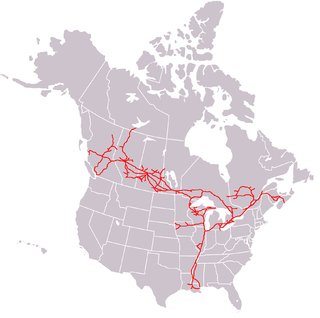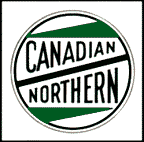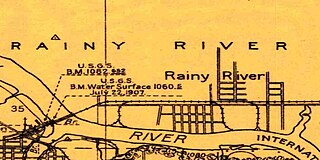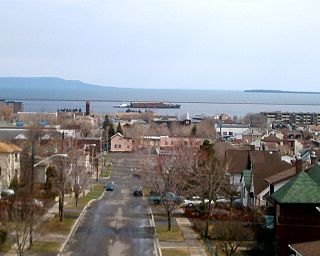
The Canadian National Railway Company is a Canadian Class I freight railway headquartered in Montreal, Quebec, which serves Canada and the Midwestern and Southern United States.

The Grand Trunk Railway was a railway system that operated in the Canadian provinces of Quebec and Ontario and in the American states of Connecticut, Maine, Michigan, Massachusetts, New Hampshire, and Vermont. The railway was operated from headquarters in Montreal, Quebec, with corporate headquarters in London, United Kingdom. It cost an estimated $160 million to build. The Grand Trunk, its subsidiaries, and the Canadian Government Railways were precursors of today's Canadian National Railway.

The Canadian Northern Railway (CNoR) was a historic Canadian transcontinental railway. At its 1923 merger into the Canadian National Railway, the CNoR owned a main line between Quebec City and Vancouver via Ottawa, Winnipeg, and Edmonton.
The National Transcontinental Railway (NTR) was a historic railway between Winnipeg and Moncton in Canada. Much of the line is now operated by the Canadian National Railway.

Rainy River is a town in north-western Ontario, Canada, southeast of Lake of the Woods. Rainy River is situated on the eponymous Rainy River, which forms part of the Ontario–Minnesota segment of the Canada–US border. Across the river is the town of Baudette, Minnesota. The two towns are connected by the Baudette – Rainy River International Bridge. Rainy River is at the northwestern terminus of Highway 11.

Southampton is a community on the shores of Lake Huron in Bruce County, Ontario, Canada. It is close to Port Elgin and is located at the mouth of the Saugeen River in the Saugeen Ojibway Nation Territory. The size of the town is 6.44 square kilometres. The permanent population in 2016 was 3,678, but the summer population is higher since cottagers and campers spend vacation time in the area.

The Duluth, Winnipeg and Pacific Railway is a subsidiary railroad of Canadian National Railway (CN) operating in northern Minnesota, United States. A CN system-wide rebranding beginning in 1995 has seen the DWP logo and name largely replaced by its parent company. The DWP line is CN's connection between International Falls and Duluth, Minnesota, where the railroad connects to a short stretch of the former Duluth, Missabe and Iron Range Railway before following the former Wisconsin Central to Chicago, Illinois.
The Toronto Suburban Railway was a Canadian electric railway operator with local routes in west Toronto, and a radial (interurban) route to Guelph.

Napanee station in Napanee, Ontario, Canada is served by Via Rail trains running from Toronto to Ottawa. The 1856 limestone railway station was an unstaffed but heated shelter with telephones and washrooms, which would open at least half an hour before a train arrives. The platform is wheelchair-accessible. As of February 2023, the shelter was locked.

A street running train is a train which runs on a track built on public streets. The rails are embedded in the roadway, and the train shares the street with other users, such as pedestrians, cars and cyclists, thus often being referred to as running in mixed traffic or sharing the road with trains. For safety, street running trains travel more slowly than trains on dedicated rights-of-way. Needing to share the right-of-way with motor vehicles can cause delays and pose a safety risk.
The Canada Atlantic Railway (CAR) was a North American railway located in Ontario, southwestern Quebec and northern Vermont. It connected Georgian Bay on Lake Huron with the northern end of Lake Champlain via Ottawa. It was formed in 1879 through a merger of two separate railway companies that John Rudolphus Booth had purchased, and reached its full extent in 1899 through a third company that he had created. The CAR was owned by Booth for several years after its completion until he agreed to sell it to the Grand Trunk Railway (GTR) in 1904.

Transport in Thunder Bay is essential to trade, which has always been the backbone of the economy, beginning with Fort Kaministiquia in 1717. When the area was first settled its many waterways were used by the voyagers and Coureur des bois to trade their goods.
The Victoria Railway was a 55.52-mile (89.35 km) long Canadian railway that operated in Central Ontario. Construction under Chief Engineer James Ross began in 1874 from Lindsay, Ontario, with authority to build through Victoria County to Haliburton, Ontario, to which it opened on November 24, 1878. The line is best known as having been built by a large group of Icelandic immigrants, who found the Kinmount winters too rough, and so they all moved to Gimli, Manitoba. The line became part of the Midland Railway of Canada and then later part of the Canadian National Railways. The line was abandoned completely by the early 1990s.

Sleeman is an unincorporated community located in Rainy River District in Northwestern Ontario, Canada. The town site is located in the center of Dawson. The original town site was along the Rainy River some 3 km south but in the early 1900s when the steam ships that traveled from Fort Frances to Rainy River and then to Rat Portage Via Lake of the Woods carrying Logs, Lumber, mail and other supplies stopped probably because the Canadian Northern Railway had finished its bridge and rail line from Winnipeg to International Falls and the docks of the great lakes located in Fort William and Port Arthur now known as Thunder Bay the town moved from the river to the rail line. The original store, coffee shop, post office building still stands today and has been renovated into a home. The town for many years held many stores, a large hotel, coffee shops, car dealership, school and a busy rail depot that served the Northern communities along Highway 621. A restaurant called The Green Onion was the local favourite. It was open 7 days a week and held indoor livery stables below for the travels from Morson who came to town to meet the trains, liquor was served here as well. Today there is only one business left, the Canada Postal outlet. Lowes Lumber, a local business for over 80 years went into bankruptcy and closed its doors in 2014. Only about 20 homes remain, even though an official town plan was made to accommodate many more. The rail siding was removed in 1993, the last of the CN hotel burned away in the late 1980s and the grocery store was demolished when the natural gas line was installed to serve the larger communities along Highway 11.

The Memory Junction Railway Museum preserved a collection of railway memorabilia in southeastern Ontario. It closed in 2017 and its collections were auctioned in 2021. It was located in the former Grand Trunk Railway station of Brighton, Ontario, which opened in 1857 and served intercity rail passengers until the 1960s.

Riverdale Railway Station was located on De Grassi Street just north of Queen Street East in Toronto, Ontario, Canada. Constructed by the Grand Trunk Railway (GTR) in 1896 as "Queen East Station", on what is now the Lakeshore East line, the station was renamed "Riverdale Station" in 1907. The Canadian National Railway (CNR) took over the station in 1923, when they absorbed the Grand Trunk Railway. CNR discontinued passenger train service at the station in 1932, later for commercial use and demolished the building in 1974.
The Hamilton and North-Western Railway (H&NW) is a former railway in Ontario, Canada. It ran north from Hamilton on the western end of Lake Ontario to Collingwood on Georgian Bay and Barrie on Lake Simcoe. Through the purchase of the Hamilton and Lake Erie Railway, the route continued south from Hamilton to Port Dover on Lake Erie.
The Hamilton and Lake Erie Railway (H&LE) is a historical shortline railway in Ontario, Canada. It ran from Hamilton to Port Dover, about 40 miles (64 km), providing trans-shipping service between Lake Erie and Lake Ontario, and with connections, to Lake Huron at Georgian Bay.

The Waterloo Junction Railway (WJR) is a short line railway in the Region of Waterloo, Ontario, Canada. It runs northward from the former Grand Trunk Railway (GTR) North Main Line in downtown Kitchener, through Waterloo and St. Jacobs before terminating in Elmira. It is currently owned by the City of Waterloo and operated by CN as the Waterloo Spur. The Waterloo Central Railway runs tourist trains on the line, and the Ion rapid transit runs on the route for a short distance.














